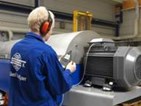The Fast And The Fourier - Bruel And Kjaer Launches A New Hand-Held Vibration Analyser

Performing high-precision vibration measurements in areas such as quality assurance, product development and vibration diagnostics is now much easier with Brüel & Kjær's hand-held, vibration analyser - Type 2250-H.
The 2250-H vibration analyser contains advanced Fast Fourier Transform (FFT) software Version 3.3, which provides simple pass/fail test results or more detailed frequency analysis for diagnostic testing, allowing engineers to make quick and easy checks of vibration performance. FFT analysis is ideal for assisting product development, quality control, building vibration analysis, troubleshooting on machinery and automotive component analysis.
The 2250-H meter's colour, touch-screen display offers a unique and intuitive measurement process, helping users to perform the tasks most often required - but not typically available on hand-held instruments - for example, in vibration testing, overlaying two measurements for comparison without needing to store results, simple drag and drop tolerance ‘windows' for pass/fail spot checks. And a simple overview display in order to view test results on up to ten different ranges, levels or parameters. It also offers user defined metadata fields and a voice commentary option for documenting repetitive measurement tasks.
Customers that already own a Brüel & Kjær 2250 or 2270 sound level meter can turn it into a focused vibration measurement tool just by loading the FFT software into their analyzer. Then - together with an accelerometer - they can start making vibration measurements.
FFT is a digital signal processing technique that converts a time record into a narrow band constant bandwidth filtered spectrum. The measurement is defined by specifying a frequency span and a number of lines (or filters). The recorded FFT is displayed by as many as 6,400 data lines on the meter's screen - which the user can select individually and expand to view the details.
SOURCE: Bruel and Kjaer
